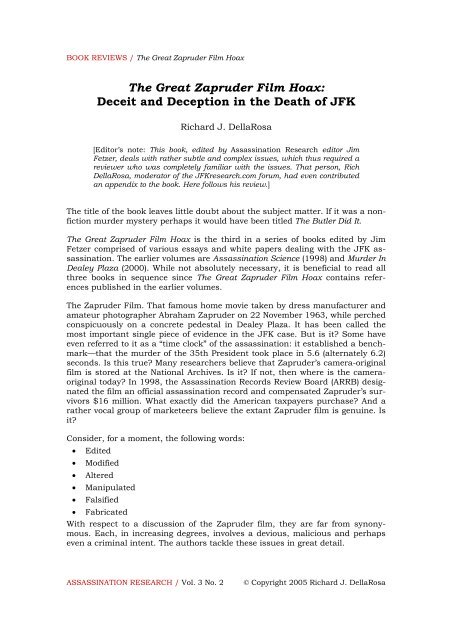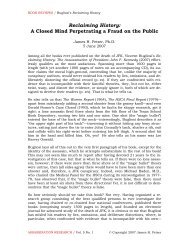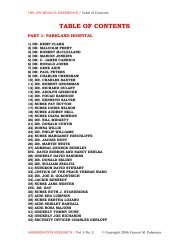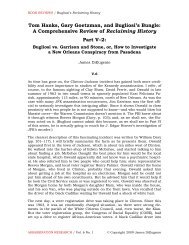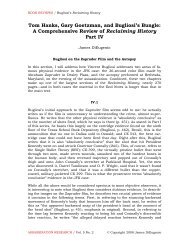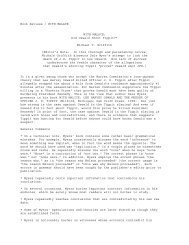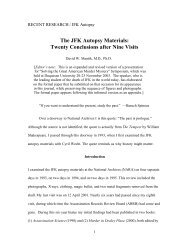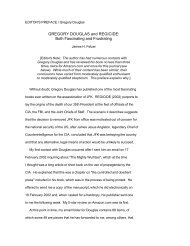The Great Zapruder Film Hoax - Assassination Research
The Great Zapruder Film Hoax - Assassination Research
The Great Zapruder Film Hoax - Assassination Research
You also want an ePaper? Increase the reach of your titles
YUMPU automatically turns print PDFs into web optimized ePapers that Google loves.
BOOK REVIEWS / <strong>The</strong> <strong>Great</strong> <strong>Zapruder</strong> <strong>Film</strong> <strong>Hoax</strong><br />
<strong>The</strong> <strong>Great</strong> <strong>Zapruder</strong> <strong>Film</strong> <strong>Hoax</strong>:<br />
Deceit and Deception in the Death of JFK<br />
Richard J. DellaRosa<br />
[Editor’s note: This book, edited by <strong>Assassination</strong> <strong>Research</strong> editor Jim<br />
Fetzer, deals with rather subtle and complex issues, which thus required a<br />
reviewer who was completely familiar with the issues. That person, Rich<br />
DellaRosa, moderator of the JFKresearch.com forum, had even contributed<br />
an appendix to the book. Here follows his review.]<br />
<strong>The</strong> title of the book leaves little doubt about the subject matter. If it was a nonfiction<br />
murder mystery perhaps it would have been titled <strong>The</strong> Butler Did It.<br />
<strong>The</strong> <strong>Great</strong> <strong>Zapruder</strong> <strong>Film</strong> <strong>Hoax</strong> is the third in a series of books edited by Jim<br />
Fetzer comprised of various essays and white papers dealing with the JFK assassination.<br />
<strong>The</strong> earlier volumes are <strong>Assassination</strong> Science (1998) and Murder In<br />
Dealey Plaza (2000). While not absolutely necessary, it is beneficial to read all<br />
three books in sequence since <strong>The</strong> <strong>Great</strong> <strong>Zapruder</strong> <strong>Film</strong> <strong>Hoax</strong> contains references<br />
published in the earlier volumes.<br />
<strong>The</strong> <strong>Zapruder</strong> <strong>Film</strong>. That famous home movie taken by dress manufacturer and<br />
amateur photographer Abraham <strong>Zapruder</strong> on 22 November 1963, while perched<br />
conspicuously on a concrete pedestal in Dealey Plaza. It has been called the<br />
most important single piece of evidence in the JFK case. But is it? Some have<br />
even referred to it as a “time clock” of the assassination: it established a benchmark—that<br />
the murder of the 35th President took place in 5.6 (alternately 6.2)<br />
seconds. Is this true? Many researchers believe that <strong>Zapruder</strong>’s camera-original<br />
film is stored at the National Archives. Is it? If not, then where is the cameraoriginal<br />
today? In 1998, the <strong>Assassination</strong> Records Review Board (ARRB) designated<br />
the film an official assassination record and compensated <strong>Zapruder</strong>’s survivors<br />
$16 million. What exactly did the American taxpayers purchase? And a<br />
rather vocal group of marketeers believe the extant <strong>Zapruder</strong> film is genuine. Is<br />
it?<br />
Consider, for a moment, the following words:<br />
• Edited<br />
• Modified<br />
• Altered<br />
• Manipulated<br />
• Falsified<br />
• Fabricated<br />
With respect to a discussion of the <strong>Zapruder</strong> film, they are far from synonymous.<br />
Each, in increasing degrees, involves a devious, malicious and perhaps<br />
even a criminal intent. <strong>The</strong> authors tackle these issues in great detail.<br />
ASSASSINATION RESEARCH / Vol. 3 No. 2 © Copyright 2005 Richard J. DellaRosa
Richard J. DellaRosa 2 <strong>The</strong> <strong>Great</strong> <strong>Zapruder</strong> <strong>Film</strong> <strong>Hoax</strong><br />
<strong>The</strong>re has been much lively debate on whether the <strong>Zapruder</strong> film was “altered”.<br />
A rather small group believes it was not. But how do we define “altered”? Understanding<br />
the established timelines and chronology of the extant film we<br />
know that there are two splices: one at frame 157 and another at frame 207. In<br />
addition, frames 208, 209, 210, and 211 are missing due to mishandling by an<br />
unnamed technician at Time-Life during the time that they had possession of it.<br />
Unaltered?<br />
Much of the “lively debate” mentioned above took place on the Internet, on the<br />
JFKresearch <strong>Assassination</strong> Forum (www.jfkresearch.com). It culminated in a<br />
Symposium sponsored by Fetzer held in Duluth in May 2003 where presentations<br />
were given by a professor of philosophy, an oncologist, a theoretical physicist,<br />
a well-known author, an expert in film and video production, and a photo<br />
analyst in the personages of James Fetzer, David Mantik, John Costella, David<br />
Lifton, David Healy and Jack White. <strong>The</strong> product of that Symposium is the sum<br />
and substance of this book.<br />
Calling the <strong>Zapruder</strong> film “evidence” doesn’t seem appropriate somehow, mainly<br />
because, from the beginning, it was not treated as evidence. If it was “evidence”<br />
it should have been seized immediately by local law enforcement or the Secret<br />
Service. Although <strong>Zapruder</strong> claimed that he was confronted in his office by a<br />
pair of armed, uniformed Dallas Police Department officers who demanded his<br />
film, he refused. Instead, he actively sought to sell it to the highest bidder.<br />
When is “evidence” ever handled in such a manner?<br />
<strong>Zapruder</strong> reported that he sold his film to Time-Life on Saturday 23 November<br />
1963 for $25,000, which he donated to the family of slain Dallas Police Department<br />
officer J. D. Tippit. In truth, he had sold the print rights to Time-Life for<br />
$50,000. That transaction allowed LIFE magazine to publish still photos made<br />
from selected frames. It did not allow them the rights to show the film as a motion<br />
picture.<br />
But, on Monday 25 November, Time-Life offered <strong>Zapruder</strong> an additional<br />
$100,000 for the movie rights as well. <strong>The</strong> total amount was paid on an annual<br />
basis over the next four years. As author David Lifton notes, that coincided exactly<br />
with LBJ’s term in office. (Note: that $150,000 is roughly equivalent to<br />
$900,000 today.) As many researchers have observed, the total transaction effectively<br />
removed the film from being accessed or viewed, except as determined<br />
by persons unknown. What is known is that the name on the agreement was<br />
C. D. Jackson of Time-Life, a man who was a close associate of former CIA director<br />
Allen Dulles and who was known to have cooperated with the CIA on occasion.<br />
<strong>The</strong> film’s provenance is rather hazy at best, and it is doubtful that it would<br />
have been admissible in a court of law if there ever had been a trial of Lee<br />
Oswald. <strong>The</strong> film was Kodachrome, which required a proprietary, patented processing<br />
which could only be accomplished in 1963 at select Kodak facilities. A<br />
piece of correspondence contained in Roland Zavada’s report to the ARRB indicated<br />
that in 1963 Kodachrome could only be processed at labs in New York,<br />
Chicago and Los Angeles. What about Dallas?<br />
ASSASSINATION RESEARCH / Vol. 3 No. 2 © Copyright 2005 Richard J. DellaRosa
Richard J. DellaRosa 3 <strong>The</strong> <strong>Great</strong> <strong>Zapruder</strong> <strong>Film</strong> <strong>Hoax</strong><br />
<strong>Zapruder</strong> stated that his film was processed at Kodak in Dallas (and there<br />
seems to be no reason, other than the abovementioned correspondence, to<br />
doubt this). <strong>The</strong> processed film was then taken by <strong>Zapruder</strong> to the Jamieson<br />
film labs so that three optical print copies could be made. Supposedly, the camera-original<br />
film and one copy were transferred to Time-Life, and two copies<br />
were given to the Secret Service. This scenario has been told and re-told dozens<br />
of times over the years.<br />
But author David Healy reports that at Jamieson, the camera-original was assigned<br />
number 0183, while the copies were given identification numbers 0185,<br />
0186 and 0187. So, what happened to 0184? Did they just skip that number,<br />
and, if so, why? Or, was there an unaccounted-for copy made?<br />
In the waning days of the brief tenure of the ARRB, a former CIA photoanalyst,<br />
Homer McMahon, provided testimony that in 1963 he worked at the National<br />
Photographic Interpretation Center (NPIC) in Washington. NPIC was a part of<br />
the CIA and was an advanced photographic facility which, among other projects,<br />
was responsible for analyzing the U2 photos which showed the build-up<br />
of Soviet missiles in Cuba in 1962.<br />
McMahon’s narrative included a report that a Secret Service agent named<br />
“Smith” delivered an amateur, 8 mm film of the assassination to NPIC on the<br />
evening of the assassination, 22 November 1963. “Smith” advised McMahon<br />
that the film had been “processed” at Eastman Kodak in Rochester, New York<br />
and then rushed on to Washington. Was this the <strong>Zapruder</strong> film? Well, so much<br />
for the supposed long-established provenance. Could the film which was delivered<br />
to NPIC be the unaccounted-for copy #0184? Copy 0184 may have been an<br />
inter-negative made by Jamieson which Kodak then “processed” in Rochester by<br />
making a positive print.<br />
McMahon reported that he was never left alone with the film and was not allowed<br />
to make copies of it. He was asked to analyze it and prepare briefing<br />
boards. His in-depth analysis was that there was evidence of six to eight shots<br />
fired at the motorcade from at least three different directions. On viewing the<br />
film ten or more times that evening, McMahon was (and still is) convinced of his<br />
conclusions.<br />
Does that description match what is seen today in the extant film? And why<br />
didn’t the Warren Commission Report or the final report of the House Select<br />
Committee on <strong>Assassination</strong>s mention that the film was sent to the CIA? By<br />
now, the answer is probably obvious.<br />
When interviewed in the 1990s, <strong>Zapruder</strong>’s business partner, Erwin Schwartz,<br />
said that he vividly recalled watching the film and remembered seeing JFK’s<br />
head suddenly “whip around to the left”, and he saw an explosion of blood and<br />
brains from his head and that it had been blown out “to the left rear”.<br />
On 13 February 1969 <strong>Zapruder</strong> said that he could not tell if frames were missing<br />
from his film nor could he vouch for the film’s chain of custody. Is it possible<br />
that <strong>Zapruder</strong> could not recognize his film?<br />
ASSASSINATION RESEARCH / Vol. 3 No. 2 © Copyright 2005 Richard J. DellaRosa
Richard J. DellaRosa 4 <strong>The</strong> <strong>Great</strong> <strong>Zapruder</strong> <strong>Film</strong> <strong>Hoax</strong><br />
<strong>The</strong> authors present discussions of the following issues:<br />
• Did Abraham <strong>Zapruder</strong> actually take the film attributed to him? <strong>The</strong>re are<br />
films and stills which seem to show <strong>Zapruder</strong> without his camera up to his<br />
face, and some which show his employee Marilyn Sitzman actually blocking<br />
his view. And a further photo shows no one standing on the pedestal.<br />
In the Willis and Betzner photos, <strong>Zapruder</strong> appears to be on the concrete<br />
pedestal shooting a movie. But in the Bronson slide a bit later, the<br />
Moorman Polaroid, and the Nix film, <strong>Zapruder</strong> does not seem to be filming<br />
at all. Yet <strong>Zapruder</strong> stated, more than once, that he began shooting his film<br />
when the motorcade came into sight on Houston Street and continued<br />
shooting until the limousine was out of sight.<br />
• Did the technology and expertise necessary to alter film exist in 1963? It is<br />
indeed fortuitous that a member of the team is David Healy, a man with<br />
extensive experience (30+ years) in video and film production who is intimately<br />
familiar with the working of optical printers and other equipment<br />
and techniques used to apply special effects to film and motion pictures.<br />
Healy demonstrated early attempts to create composite images. In one<br />
case, a work called “Fading Away” by Henry Robinson was shown. It is<br />
composed of ten separate images yet there are no visible cut lines and it<br />
displays an even density across all ten image pieces. <strong>The</strong> end result is quite<br />
remarkable and is reproduced in the book. Even more astounding is that it<br />
was created in 1858—more than a century before the JFK assassination.<br />
• Were other films and photos taken that day also altered in order to agree<br />
with what is shown in the extant <strong>Zapruder</strong> film? One very vocal member of<br />
the anti-alteration camp uses this argument to prove that the <strong>Zapruder</strong><br />
film could not have been altered. In other words, since other films and photos<br />
seem to show similar events in Dealey Plaza, the <strong>Zapruder</strong> film must<br />
then be genuine. He uses other pieces of photography to verify what is seen<br />
on the <strong>Zapruder</strong> film. But this begs the question: if the <strong>Zapruder</strong> film was<br />
altered, why wouldn’t other photos and films be likewise altered? Would it<br />
not have been absolutely ridiculous to alter one piece of photographic evidence<br />
and not any other?<br />
• If the <strong>Zapruder</strong> film was altered, why was it done? When the extant<br />
<strong>Zapruder</strong> film became available for public consumption, the majority of<br />
those viewing it felt that it proved there was a frontal shot and therefore it<br />
seemingly showed the Warren Commission wrong. So why would anyone<br />
need to alter it? <strong>The</strong> authors explore this in great detail. Knowing what is<br />
seen in the extant film, one’s imagination can only wonder what any alterations<br />
would conceal. It would be entirely reasonable that anything not consistent<br />
with the Warren Commission’s conclusions would need to be edited<br />
out. Would an unaltered film completely destroy the Warren Report? Would<br />
it show, as Homer McMahon described, six or more shots fired from three<br />
or more directions? Would the alterations themselves be prima facie proof<br />
of a massive government cover-up?<br />
ASSASSINATION RESEARCH / Vol. 3 No. 2 © Copyright 2005 Richard J. DellaRosa
Richard J. DellaRosa 5 <strong>The</strong> <strong>Great</strong> <strong>Zapruder</strong> <strong>Film</strong> <strong>Hoax</strong><br />
• Who was Abraham <strong>Zapruder</strong>? Did he merely serendipitously appear in a<br />
key location to witness and record a major piece of history? In this reviewer’s<br />
opinion these are questions which deserve far more attention. We<br />
learn that <strong>Zapruder</strong> was born in Russia and that he was associated with<br />
Dallas’s White-Russian community, as was Lee and Marina Oswald, Ruth<br />
and Michael Paine, and George DeMohrenschildt. In fact, we learn that<br />
Jeanne LeGon, one of DeMohrenschildt’s wives, worked for <strong>Zapruder</strong> as a<br />
dress designer. One of Jack Ruby’s janitors also worked for <strong>Zapruder</strong> for a<br />
time, and <strong>Zapruder</strong> was also an acquaintance of Jack Ruby himself.<br />
<strong>Zapruder</strong> was also an associate of H. L. Hunt. Author Lifton states his belief<br />
in the serendipity theory, that <strong>Zapruder</strong> was just an innocent bystander<br />
with a camera, while apparently the other authors believe there<br />
may be far more to Mr. <strong>Zapruder</strong> than what we have been told (but not<br />
that <strong>Zapruder</strong> had any actual foreknowledge of the events that day).<br />
• Does the extant film show the true and accurate events that occurred in<br />
Dealey Plaza on 22 November 1963? Well, if it did, this book and the Symposium<br />
that spawned it would not have been necessary. In fact, the film<br />
does not agree with the accounts of the closest eyewitnesses. Several dozen<br />
of them described a brief limousine stop just prior to the fatal head shot.<br />
Yet the extant film depicts the limousine proceeding down Elm Street at a<br />
rather smooth, constant rate of speed. So, if it is altered, what does the extant<br />
film conceal? First and foremost it conceals evidence of more than<br />
three shots from more than a single shooter firing from the rear. That alone<br />
would invalidate the Warren Commission Report. Next, it conceals the possible<br />
complicity of one or more of the Secret Service agents. It conceals the<br />
limousine stop, which made the head shot (or shots) easier to accomplish.<br />
Did Secret Service driver Greer stop the limousine on purpose, or on cue?<br />
Author David Mantik states that he believes that JFK was hit by two head<br />
shots: one from the rear and one from the right front. He believes they occurred<br />
roughly at <strong>Zapruder</strong> frames 313 and 321. Yet the extant film shows<br />
nothing of the sort. This two-shot scenario also concurs with many eyewitness<br />
accounts.<br />
• Was Mary Moorman standing in the street when she snapped her famous<br />
photo? And if so, why does it matter? This one particular topic was the<br />
subject matter for a lengthy exchange between the authors and one of the<br />
anti-alteration teams and took place on the JFKresearch <strong>Assassination</strong> Forum<br />
on-line. To say that this issue created a spirited debate is quite an<br />
understatement. Author John Costella summarized the Moorman-in-thestreet<br />
issue thusly:<br />
An analysis by Jack White in which he claims that the lines of sight inherent<br />
in Moorman #5 located her camera position precisely—at such a height<br />
that she must have been standing on the roadway of Elm Street—whereas<br />
the (extant) <strong>Zapruder</strong> film shows her standing on the grass some feet behind<br />
the curb.<br />
Both Mary Moorman and her companion that day, Jean Hill, repeated their<br />
claims that Mary stood in the street to take her picture. Since the extant<br />
<strong>Zapruder</strong> film shows Moorman to be standing on the grass, either the two<br />
ASSASSINATION RESEARCH / Vol. 3 No. 2 © Copyright 2005 Richard J. DellaRosa
Richard J. DellaRosa 6 <strong>The</strong> <strong>Great</strong> <strong>Zapruder</strong> <strong>Film</strong> <strong>Hoax</strong><br />
women were mistaken—or—the film was altered. But the authors did not<br />
merely need to rely on the women’s memory. Jack White noticed that the<br />
intersection of two lines-of-sight involving the windows in the concrete pergola<br />
and the top of the concrete pedestal on which <strong>Zapruder</strong> stood could<br />
only occur when sighted from the exact location where Moorman said she<br />
was standing: in Elm Street itself. In 2001, authors White, Mantik, and<br />
Fetzer utilized surveyor’s equipment to locate the spot exactly in Dealey<br />
Plaza. <strong>The</strong> conclusion is inevitable: the extant film has been altered—<br />
significantly.<br />
• Has the <strong>Zapruder</strong> family been unfairly enriched? As noted above, the total<br />
amount paid to <strong>Zapruder</strong> by Time-Life was $150,000. In 1975, Time sold<br />
the film and all of its copyrights to <strong>Zapruder</strong>’s survivor and family for<br />
$1.00. <strong>The</strong>y formed the LMH Corporation and hired an attorney to function<br />
as a “royalty cop”. If anyone wished to use the <strong>Zapruder</strong> film or portions of<br />
it, a royalty had to be paid in every case. Royalties ranged from $3,000 to<br />
the $80,000 that Oliver Stone paid in order to use the film in his movie<br />
JFK. In the late 1990s, the ARRB declared the <strong>Zapruder</strong> film to be an assassination<br />
record consistent with the JFK Records Act which empowered<br />
them. Federal law mandates that when the government takes possession of<br />
private property compensation must be made representing a “fair value”.<br />
<strong>The</strong> ARRB determined the film to have a market value of $16 million and<br />
paid that amount to the <strong>Zapruder</strong>s, with the <strong>Zapruder</strong>s retaining the copyrights.<br />
Said copyrights were transferred subsequently to the Dallas Historical<br />
Foundation, doing business as <strong>The</strong> Sixth Floor Museum at Dealey<br />
Plaza.<br />
But, as the authors advise, if the <strong>Zapruder</strong> film is altered—that is, if it not<br />
a genuine photographic record of the JFK assassination—has the <strong>Zapruder</strong><br />
family been unfairly enriched using taxpayer monies? If so, should the<br />
<strong>Zapruder</strong>s re-pay it? This is not a trivial issue because it lies at the heart<br />
and soul of the anti-alterationists. <strong>The</strong>y have demonstrated that their interest<br />
isn’t the preservation of an historical document. Rather, their true<br />
interests are quite parochial and mercenary. Specifically, if those who seek<br />
to profit from the extant film admit that the film has been tampered with<br />
and is not genuine, the value diminishes to nothing more than evidence of<br />
one of the biggest hoaxes ever perpetuated on the American people and the<br />
world community. Hence the anti-alterationists have demonstrated that<br />
they will stop at nothing to discredit any and all proof of the film’s alteration,<br />
manipulation, and downright fabrication.<br />
<strong>The</strong>se issues and others are presented by the authors in this compelling book.<br />
Whether one becomes convinced of <strong>Zapruder</strong> film alteration after reading this<br />
book is a matter of choice, but not for lack of information or substantiation.<br />
Of all the presenters who traveled to Duluth for the Symposium, the one who<br />
traveled farthest was Dr. John Costella, a theoretical physicist from Australia.<br />
Dr. Costella is something of a newcomer to the area of JFK research but he has<br />
made astounding contributions already.<br />
ASSASSINATION RESEARCH / Vol. 3 No. 2 © Copyright 2005 Richard J. DellaRosa
Richard J. DellaRosa 7 <strong>The</strong> <strong>Great</strong> <strong>Zapruder</strong> <strong>Film</strong> <strong>Hoax</strong><br />
One of the more fascinating discoveries Costella has made involves the Stemmons<br />
Freeway sign in Dealey Plaza. As it turns out, the lens system on<br />
<strong>Zapruder</strong>’s camera was patented by Bell & Howell; its characteristics are well<br />
documented. As many are aware, <strong>Zapruder</strong>’s Bell & Howell Director’s Series<br />
414PD camera was set on telephoto while he filmed the presidential motorcade.<br />
This lens has a characteristic “pincushioning” effect which tends to pull the image<br />
frames outward.<br />
This pincushioning effect is clearly present in the extant <strong>Zapruder</strong> film, as it<br />
should be. Except there is no pincushioning detected for the Stemmons Freeway<br />
sign along Elm Street—and there should be.<br />
Costella shows that it is physically impossible for pincushioning to occur in<br />
portions of movie frames selectively while other portions are free from the distortion.<br />
How could the Stemmons sign have escaped the pincushioning?<br />
<strong>The</strong> short and undeniable answer is that the Stemmons Freeway sign, as it appears,<br />
was inserted into the film after it was processed. <strong>The</strong> sign should have<br />
had the same pincushion distortion as the rest of the frame as well as all the<br />
frames before and after the ones in which the sign appears.<br />
Recall that the extant film shows JFK smiling and waving to the crowd prior to<br />
disappearing behind the sign. When he re-emerges he has his hands up to his<br />
throat as he reacts to being shot. Irrefutably, the Stemmons sign obscures the<br />
throat shot—a frontal throat shot. Some researchers have theorized that the<br />
sign was also struck by a shot from the grassy knoll. (<strong>The</strong> sign was not made of<br />
metal but was plywood.) Are these the reasons an artificial sign was inserted<br />
into the extant film? If so, Costella reasons, the extant film was not merely “altered”—it<br />
was “fabricated”. Fabricated, as in “falsified”—with criminal intent,<br />
since obstructing justice was, and still is, a crime.<br />
Consider, also, that we are told that <strong>Zapruder</strong> carefully selected his position<br />
and, although he stated that he suffered from vertigo, he chose to stand<br />
perched on top of that concrete pedestal. Yet, his closest point of view (POV) of<br />
the motorcade had a sign obstructing it. As author Healy notes, if <strong>Zapruder</strong> had<br />
chosen to stand at ground level in front of the pergola structure, he would have<br />
enjoyed an unobstructed view.<br />
<strong>The</strong> final presentation is an interesting narrative by author David Lifton, detailing<br />
his 30+ years of experience studying and analyzing the <strong>Zapruder</strong> film and<br />
his early suspicions of its alteration and forgery. Lifton is familiar to students of<br />
the JFK case mainly due to his best selling book Best Evidence which explored<br />
the possibility of body alteration. In this treatise he deals with film alteration.<br />
In fact it was Lifton who wrote to Warren Commission photo expert Shaneyfelt<br />
in 1965 to point out that two frames published in Volume 18 appeared to be<br />
reversed. As a result he received a letter from no less than J. Edgar Hoover explaining<br />
that it was due to a “printing error”. Later, on close examination of the<br />
film, Lifton noted that frames 335 and 337 showed what seemed to be a<br />
painted-on head wound which did not fit the description that nearly all of the<br />
ASSASSINATION RESEARCH / Vol. 3 No. 2 © Copyright 2005 Richard J. DellaRosa
Richard J. DellaRosa 8 <strong>The</strong> <strong>Great</strong> <strong>Zapruder</strong> <strong>Film</strong> <strong>Hoax</strong><br />
Parkland doctors saw only moments later. Suspiciously, the head wound did<br />
match the description given later by the Bethesda autopsists.<br />
Author David Healy believes that the famous “blob” wound seen in some copies<br />
in the vicinity of <strong>Zapruder</strong> frame 313 and the head wound noted by Lifton in<br />
frames 335 and 337 were created using a piece of glass placed over those<br />
frames. <strong>The</strong> artifacts then were painted onto the glass by a highly skilled matte<br />
artist. Lifton then points out that the most accomplished matte artists in the<br />
world are employed by the movie studios in Hollywood, and raised suspicions of<br />
whether the <strong>Zapruder</strong> film could have been sent to one of them for alteration.<br />
But a matte artist would not be able to work with an 8 mm image, as it is far<br />
too small.<br />
Enter Moses Weitzman, a highly talented motion picture technician in New<br />
York. Clearly, Weitzman was not a party to any of the subterfuge or alteration.<br />
However, in 1967 Time-Life approached Weitzman and requested him to make a<br />
16 mm copy of the 8 mm <strong>Zapruder</strong> film. Weitzman perfected a technique which<br />
actually allowed him to make a 35 mm copy from 8 mm in one step. But was<br />
the film given to Weitzman for copying the camera-original or an already altered<br />
copy?<br />
An email from Weitzman to this reviewer dated 10 July 2003 states, “I can assure<br />
you I had the original unaltered, slit, regular 8 mm footage. It would have<br />
been technically impossible to do any matte work or even optical printing.” Author<br />
Lifton disagrees. <strong>The</strong> creation of 35 mm frames was key, in his opinion, to<br />
the creation of matte images superimposed to alter the images of JFK’s wounds.<br />
Weitzman could not have known whether the 8 mm film was the cameraoriginal.<br />
In the same communication, Weitzman wrote, “An employee of mine pirated a<br />
copy and made a career of it.” Enter Robert Groden. David Lifton has had an<br />
interesting history with Robert Groden over the past thirty years which he describes<br />
in some detail in this book. In Lifton’s stated opinion, Groden has<br />
adopted the belief that he (Groden) personally owns any JFK-related material<br />
that he touches. This has been problematic in having some of those items available<br />
to bona fide researchers. Having worked with the House Select Committee<br />
on <strong>Assassination</strong>s as a photoanalyst, Groden has had access to plenty.<br />
Moses Weitzman also had the opportunity to work on the Nix film for UPI. When<br />
he viewed the Nix film on a Hazeltine analyzer at 8X magnification, he wrote in<br />
a subsequent email to this reviewer: “To <strong>Zapruder</strong>’s right there was a picket<br />
fence and behind that fence a clearly discernable image of what looked like a<br />
person holding a silver rod (about what a rifle barrel would look like) at port position.<br />
We sent several copies to the Jet Propulsion Lab at CalTech. Unfortunately<br />
they could only do black and white. <strong>The</strong>y lost the nuances of color that<br />
shaped the image. A flesh-colored void where a head should be, two smaller<br />
flesh-colored blobs holding a silver-colored broom stick … <strong>The</strong>y could not find<br />
anything on what we sent them.” And later commented, “<strong>The</strong> original Nix footage<br />
and the blowups we made seemed to have melted away.” So, what has happened<br />
to the original Nix film? David Lifton has his suspicions.<br />
ASSASSINATION RESEARCH / Vol. 3 No. 2 © Copyright 2005 Richard J. DellaRosa
Richard J. DellaRosa 9 <strong>The</strong> <strong>Great</strong> <strong>Zapruder</strong> <strong>Film</strong> <strong>Hoax</strong><br />
When the alterations were made to the <strong>Zapruder</strong> film is not clear. <strong>The</strong>re appears<br />
to be concurrence by the authors that some were done the very weekend<br />
of the assassination. But since the film was withheld from the public for some<br />
twelve years, there is no way to know when and where other modifications were<br />
accomplished. This all nets out to the authors’ assertion that the extant<br />
<strong>Zapruder</strong> film is not an authentic representation of what occurred in Dealey<br />
Plaza on 22 November 1963. It does not concur with the descriptions of the<br />
closest eyewitnesses. It is not merely an altered film, but a total fabrication. In<br />
fact, the extant film may have been constructed using not only <strong>Zapruder</strong>’s film,<br />
but other films taken that day. This may account for <strong>Zapruder</strong> choosing such a<br />
poor POV—he may have been a decoy intended to distract attention from other<br />
cameramen concealed nearby.<br />
For a relatively small cadre of researchers, the <strong>Zapruder</strong> film alteration issue is<br />
moot. <strong>The</strong>y have seen another film of the assassination—a better quality film. A<br />
description of it is reproduced in Appendix E of this book. <strong>The</strong>se fortunate folks<br />
have seen a film which closely matches the eyewitness accounts, and is very<br />
different from the extant <strong>Zapruder</strong> film. This “other” film shows the limousine<br />
turning from Houston Street onto Elm Street; it shows the limousine coming to<br />
a full, yet brief, stop; it shows a man stepping into the street with fist raised—<br />
possibly a signal for the driver to stop; it shows two shots to JFK’s head from<br />
two directions; and it shows a shower of brain particulate violently sprayed to<br />
the left rear.<br />
It is important to note that none of the people who claim to have seen this film<br />
ever did so in the presence of any of the others. Nor did they view it in the same<br />
geographic location. Yet their descriptions of what they saw in the film match<br />
identically. For them, there is no question that the extant <strong>Zapruder</strong> film is a<br />
fabrication, part and parcel of a massive cover-up of the assassination of President<br />
John F. Kennedy.<br />
Whether one agrees with the conclusions of the authors, this is an important<br />
book for researchers and students alike. <strong>The</strong> authors have amassed a considerable<br />
amount of substantiation for their claims, and the amount of effort is significant.<br />
As the book goes into its second printing the finishing touches are being<br />
made on a video production of the Symposium conducted in May 2003.<br />
[Editor’s note: DVDs of the Duluth conference, “Is Seeing Believing in the <strong>Assassination</strong><br />
of JFK?”, are now available at assassinationscience.com/zdvd. <strong>The</strong><br />
<strong>Great</strong> <strong>Zapruder</strong> <strong>Film</strong> <strong>Hoax</strong> is currently in its 3rd printing.]<br />
ASSASSINATION RESEARCH / Vol. 3 No. 2 © Copyright 2005 Richard J. DellaRosa


